Related Research Articles
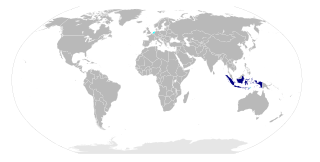
Indonesian is the official and national language of Indonesia. It is a standardized variety of Malay, an Austronesian language that has been used as a lingua franca in the multilingual Indonesian archipelago for centuries. Indonesia is the fourth most populous nation in the world, with over 270 million inhabitants—of which the majority speak Indonesian, which makes it one of the most widely spoken languages in the world.

Malay is an Austronesian language that is an official language of Brunei, Indonesia, Malaysia, and Singapore, and that is also spoken in East Timor and parts of the Philippines and Thailand. Altogether, it is spoken by 290 million people across Maritime Southeast Asia.
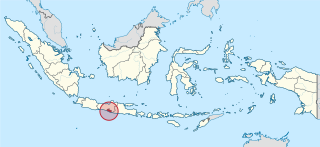
The Special Region of Yogyakarta is a provincial-level autonomous region of Indonesia in southern Java.

Balinese is a Malayo-Polynesian language spoken by 3.3 million people on the Indonesian island of Bali as well as Northern Nusa Penida, Western Lombok, Eastern Java, Southern Sumatra, and Sulawesi. Most Balinese speakers also know Indonesian. The Bali Cultural Agency estimated in 2011 that the number of people still using the Balinese language in their daily lives on the Bali Island is under 1 million. The language has been classified as "not endangered" by Glottolog.

Javanese is a Malayo-Polynesian language spoken by the Javanese people from the central and eastern parts of the island of Java, Indonesia. There are also pockets of Javanese speakers on the northern coast of western Java. It is the native language of more than 98 million people.

Minangkabau is an Austronesian language spoken by the Minangkabau of West Sumatra, the western part of Riau, South Aceh Regency, the northern part of Bengkulu and Jambi, also in several cities throughout Indonesia by migrated Minangkabau. The language is also a lingua franca along the western coastal region of the province of North Sumatra, and is even used in parts of Aceh, where the language is called Aneuk Jamee.
Malaysian Sign Language is the principal language of the deaf community of Malaysia. It is also the official sign language used by the Malaysian government to communicate with the deaf community and was officially recognised by the Malaysian government in 2008 as a means to officially communicate with and among the deaf, particularly on official broadcasts and announcements. BIM has many dialects, differing from state to state.
Kod Tangan Bahasa Malaysia (KTBM), or Manually Coded Malay, is a signed form of the Malay language recognized by the government in Malaysia and the Malaysian Ministry of Education. It is used as an aid to teachers teaching the Malay language to deaf students in formal education settings. It is not itself a language, but a manually coded form of Malay. It was adapted from American Sign Language, with the addition of some local signs, plus grammatical signs to represent Malay affixation of nouns and verbs. It is used in Deaf schools for the purpose of teaching the Malay language.

Hong Kong English is a variety of the English language native to Hong Kong. The variant is either a learner interlanguage or emergent variant, primarily a result of Hong Kong's British overseas territory history and the influence of native Hong Kong Cantonese speakers.

Petrus Josephus Zoetmulder S.J. was a Dutch expert in the Old Javanese language. He came from Utrecht and was associated with the Society of Jesus by 1925. He worked at Leiden University in the 1930s. His first work appeared in 1930 and he continued to write into the 1990s. He lived in Yogyakarta and was interred in the Jesuit necropolis at Muntilan, Java.

Herman Johannes was an Indonesian professor, scientist, politician and National Hero. Johannes was the rector of Universitas Gadjah Mada in Yogyakarta (1961–1966), Coordinator for Higher Education from 1966 to 1979, a member of Indonesia's Presidential Supreme Advisory Council from 1968 to 1978, and the Minister for Public Works and Energy (1950–1951). He was also a member of the Executive Board of UNESCO from 1954 to 1957.
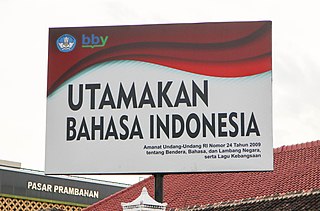
More than 700 living languages are spoken in Indonesia. These figures indicate that Indonesia has about 10% of the world's languages, establishing its reputation as the second most linguistically diverse nation in the world after Papua New Guinea. Most languages belong to the Austronesian language family, while there are over 270 Papuan languages spoken in eastern Indonesia. The language most widely spoken as a native language is Javanese.
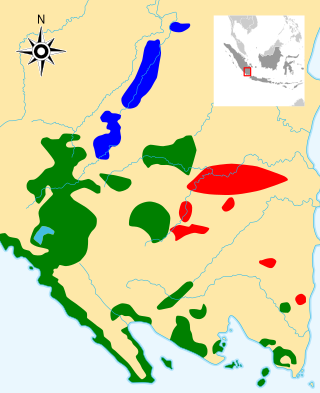
Lampung or Lampungic is an Austronesian language or dialect cluster with around 1.5 million native speakers, who primarily belong to the Lampung ethnic group of southern Sumatra, Indonesia. It is divided into two or three varieties: Lampung Api, Lampung Nyo, and Komering. The latter is sometimes included in Lampung Api, sometimes treated as an entirely separate language. Komering people see themselves as ethnically separate from, but related to, Lampung people.

The Banjar or Banjarese is an Austronesian language predominantly spoken by the Banjarese—an indigenous ethnic group native to Banjar regions— in the southeastern Kalimantan of Indonesia. The Banjarese language is the de facto lingua franca for various indigenous community especially in South Kalimantan, as well as Central Kalimantan and East Kalimantan in general.

Acehnese or Achinese is an Austronesian language natively spoken by the Acehnese people in Aceh, Sumatra, Indonesia. This language is also spoken by Acehnese descendants in some parts of Malaysia like Yan, in Kedah.
Palembang, also known as Palembang Malay, or Musi, is a Malayic language primarily spoken in about two thirds of South Sumatra Province in Indonesia, especially along the Musi River. It consists of two separate but mutually intelligible dialect chains: Musi and Palembang. The urban Palembang dialect is a koiné that emerged in Palembang, the capital city of South Sumatra. It has become a lingua franca throughout major population centers in the province, and is often used polyglossically with Indonesian and other regional languages and dialects in the area. Since parts of South Sumatra used to be under direct Malay and Javanese rule for quite a long time, the speech varieties of Palembang and its surrounding area are significantly influenced by Malay and Javanese, down to their core vocabularies.
Larantuka Malay is a contact variety of Malay spoken in and around the city of Larantuka on the island of Flores in Indonesia, and in two enclaves: the village of Wure on the island of Adonara and four villages on Konga Bay, about 40 kilometers south of Larantuka on Flores, and serves more generally as a lingua franca on the eastern tip of Flores and nearby islands. There are approximately 23,000 native speakers of Larantuka Malay. Second language speakers of Larantuka Malay are primarily found in and around the city of Larantuka and through the eastern part of Flores island, as well as the nearby islands of Adonara, Solor and Lembata (Lomblen), and natively speak Lamaholot or other languages closely related to Lamaholot, which, until recently, were believed to be dialects of Lamaholot. The city of Larantuka today is a fairly homogeneous community, and although it is largely made up of speakers of Larantuka Malay, many of whom who trace their ancestry back to Portuguese settlers and their followers from the Malay peninsula who arrived in Larantuka in the 17th century, it actually had roots in diverse communities drawn to the settlement. The Larantuka Malay community maintains a separate cultural and linguistic identity from the Lamaholot speakers who surround the city. Larantuka Malay serves as the main language of daily life in the city, and is the native language of a majority of the population.
Kendayan, or Salako (Selako), is a Malayic Dayak language of Borneo. The exact number of speakers remains unknown, but is estimated to be around 350,000.
This article explains the phonology of Malay and Indonesian based on the pronunciation of Standard Malay, which is the official language of Brunei, Singapore and Malaysia and Indonesian which is the official language of Indonesia and a working language in Timor Leste. Bruneian Standard Malay and Malaysian Standard Malay follow the Johor-Riau Pronunciation, while Singaporean Standard Malay and Indonesian follow the Baku Pronunciation.
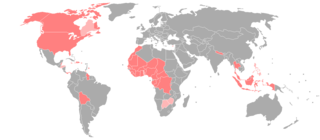
American Sign Language (ASL) developed in the United States and Canada, but has spread around the world. Local varieties have developed in many countries, but there is little research on which should be considered dialects of ASL and which have diverged to the point of being distinct languages.
References
- ↑ Indonesian Sign Language at Ethnologue (25th ed., 2022)

- ↑ Silva Tenrisara Pertiwi Isma, 2012, "Signing Varieties in Jakarta and Yogyakarta" Archived 2014-01-13 at the Wayback Machine